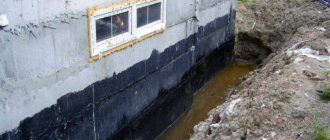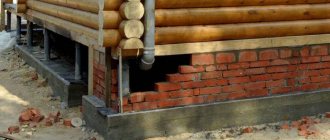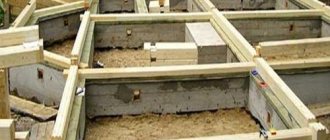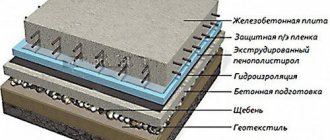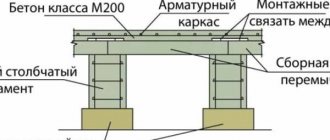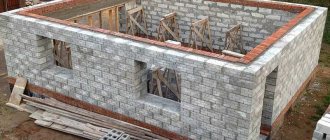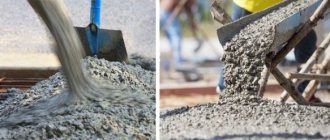Preserving the foundation in winter: options
To ensure that the foundation of the future house, previously poured and completely ready for further work, does not crack over the winter, it can be preserved in one of several ways:
- cover with thick construction film, sprinkle soil on top and press down with stones;
- protect from excess dampness and water using drainage;
- make additional waterproofing on all sides of the base of the house;
- cover the base of the building with one of the types of greenhouses;
- insulate the outer sides of the foundation with polystyrene foam, and backfill with non-metallic material in a 20 cm layer with mandatory compaction of the soil.
Of course, each type of base requires its own conservation. But these methods can be combined and used for any ready-made base. After all, the main reasons for the destruction and deformation of the flooded foundation of a house are increased heaving, the proximity of groundwater and the lack of load on the foundation.
Having eliminated one or more causes of damage to the foundation during the winter season, you can safely leave the foundation of the house for the winter.
How to preserve the foundation for the winter?
The final quality of the entire building will depend on how correctly the foundation is preserved for the winter. There are several ways to preserve the erected foundation of a building during the winter:
- Cover the foundation with one of the types of greenhouse.
- Drain the soil to protect the base from excess water. Additionally, waterproofing should be laid around the perimeter of the poured foundation.
- Cover with thick construction film, cover with a small amount of earth and press down with stones.
- Cover with polystyrene foam on the outside. Backfilling in this case should be carried out with non-metallic material, and compaction of the soil in this case is mandatory.
Naturally, each type of foundation requires its own conservation technology and this must be taken into account. The degree of concrete’s ability to withstand sub-zero temperatures is determined by the time period that has passed since it was poured and what types of work were completed before the onset of frost.
You can leave the support without cover only in cases where the pouring was done more than a month ago at a temperature above 0 o, and its sides and top are covered with waterproofing material.
Proper backfilling will protect the foundation from liquid that may get under the base during the spring melting of snow and autumn rains. Waterproofing is used only for concrete with low density, since it absorbs moisture well, which, getting into microcracks and seams, can break it when it freezes. But if you are the owner of a site with a low groundwater level and dry soil, then it will be enough to cover the base with any material that does not allow water to pass through.
Conservation by snow retention.
What is conservation of construction for the winter?
So, individual housing construction projects, that is, private low-rise construction, are usually mothballed for the winter. Why does conservation not affect commercial construction sites (in particular, multi-storey buildings under construction), which, as we can all observe, continue to be built even in severe January frosts? Economic reasons play the dominant role here: the cost of a facility downtime for at least 1 calendar day reaches half a million US dollars (depending on the scale of construction), so technologists and engineers here do not skimp on materials:
Preservation of an unfinished house for the winter
- special components based on salts and polymers are added to the solutions to prevent water from freezing even at -40°C;
- the constructed structure is heated from the inside by special powerful heat guns.
We will tell you further how to do this correctly, so as not to expose the already erected structure to the danger of damage and destruction from frost, and also to avoid simply overpaying for the measures taken.
Consequences of lack of conservation of a construction site
To leave everything as it is and not carry out any work at all means to “kill” the construction site with your own hands, so it is simply necessary to carry out at least the minimum and easily accessible complex of protection for long-term construction. But it is worth considering that some events cannot be avoided, and some can be excluded to save money.
Conservation is a series of measures aimed at preserving an already erected structure from destruction when exposed to atmospheric factors, and it is not a bad idea to worry about the safety of the construction site for others. At the same time, conservation makes it possible to quickly put the object into construction in the spring without additional preparatory and restoration work.
Conservation itself implies drainage of water and protection from moisture of the construction site and stored materials purchased for future use. Without protective cover, building materials accumulate moisture, which, when frozen, destroys their structure. Moreover, even if at first glance, after defrosting, no damage is detected, it still exists: at a minimum, a decrease in the strength of the material due to microcracks, and at a maximum, subsequent rapid destruction (delamination).
How to preserve the foundation for the winter?
Korovin Sergey Dmitrievich
Master of Architecture, graduated from Samara State University of Architecture and Civil Engineering. 11 years of experience in design and construction.
Foundation conservation is understood as a set of measures to protect building structures from adverse environmental influences during the cold season. The need for protection arises in the event of a forced stop in construction due to the impossibility of completing it before the onset of frost.
The main factors contributing to the destruction of the foundation in winter are:
- exposure to moisture;
- low air temperature and its sudden changes;
- deformation pressure from soil heaving.
The list of protective measures taken and work performed depends on the type of foundation, its size, lower support point, freezing depth, type and composition of soil.
Features of conservation of foundations for a long period
If you understand that the construction of the building will be suspended for more than a year, then with the onset of construction you will have to partially re-open the foundation and perform additional work. For this:
- remove plastic film from all surfaces so that the concrete and masonry dry well during the summer;
- extend and make drainage lines according to a permanent work pattern;
- arrange a permanent blind area around the perimeter of the entire building;
- install a lightning drain at least 10 meters high, mount a drain from it and a grounding circuit;
- ensure reliable waterproofing of all vertical and horizontal surfaces.
In order to reduce the lateral pressure of the soil during heaving and maintain the thermal insulation properties of the material, use insulation for walls with a thickness of at least 100 mm. All these measures will allow you to preserve the foundation for up to 5 years without continuing construction.
Insulation of foundations for the winter period
Since the most difficult operation to preserve the foundation of a house in winter is insulating it on each side, it is worth considering such work in more detail.
Such work should be carried out immediately after the foundation itself has dried, when the formwork is removed. Then you can not only leave the base of the house unloaded in winter, but also get warmer floors later, when the building is built.
The insulation process will look like this:
- polymer-bitumen mastic is applied to the vertical surfaces of the tape (supports, slabs) as a waterproofing layer - this will prevent moisture from spoiling the finished base;
- The vertical sides of the base are covered with expanded polystyrene slabs, using adhesive compounds for this - this will insulate the foundation and additionally protect it from damage;
- additional finishing of the slabs attached to the base is carried out using plaster - this will extend the service life of the foundation for many years;
- backfilling is carried out with non-metallic material in a layer of at least 18 cm with dense compaction.
Of course, the cost of materials and funds for such a foundation will be much greater than when creating a simple foundation. But the heat savings in the house during its operation will cover these costs in the first year of residence. And the likelihood of damage to the foundation from heaving is reduced to a minimum.
Conservation of the construction of brick and block (foam block, gas block, shell rock) house
First floor without ceiling
Builders do not recommend winterizing the construction of a house at this stage. It is advisable that the walls already have a ceiling laid.
It is very important that there is a reinforcing belt along the top of the walls. If winter occurs at the construction stage, when the reinforcing belt has not yet been laid, then without protective measures water gets inside the bricks (or blocks), which leads to their destruction and guarantees efflorescence on the brick in the spring
If the wall is multilayer (well) and insulation is laid between the two walls, then remaining uncovered the insulation will absorb moisture, and the water in it will freeze and expand, which will completely destroy the structure of the material, and thereby render it unusable.
Therefore, preserving the house at this stage is labor-intensive and does not guarantee complete safety of the walls from getting wet and possible cracking.
If conservation is still necessary at this stage, builders recommend:
- Cover the top of the wall with waterproofing film, then load the film with bricks, or bend it in two directions, then press it against the wall with boards and nail it.
The same is done at the window sill level. Waterproofing walls - Free-standing walls erected above the floors must be braced (with struts or struts) if their height exceeds 3.1;
5.6; and 6.5 m with a masonry thickness of 38, 51 and 64 cm, respectively. Spacers - Inside the house, the floors are covered with straw mats (to protect the soil from freezing and heaving) and waterproofing film, the film is pressed with soil or sand to the walls from the inside, raising it by 20-30 cm.
- If there is a financial opportunity, then it is worth installing temporary lathing floors.
Place a waterproofing film or roofing felt on top of the sheathing and press it with bricks. Temporary overlap - There is no need to close the walls from the outside.
- Cover door and window openings with boards, sheets of metal, roofing felt or plastic film.
Windows and doors covered with plywoodWindows covered with roofing felt
Windows boarded up
- Water is removed from the house by leveling the surface of the site or using a ditch system (described above).
Protection of the first floor with overlap
This stage is more favorable for preservation for the winter.
Necessary activities:
- Lay waterproofing (roofing felt, PE film) over the ceiling, overlap it, seal the joints with adhesive tape, and securely load bricks on top from the wind. The edges of the hanging film are pressed against the wall with slats and nailed.
- Close door and window openings with boards, metal sheets, roofing felt or PE film.
- At this stage, it is already worth making a blind area that will protect the foundation from water flowing from the ceiling.
- Water is drained from the house by leveling the surface of the site or by installing a system of grooves described above.
The house has been roofed, the rafters have been laid, but not yet covered with roofing material
Rafter part without roofing material
At this stage, the walls were erected, the ceiling above the first floor and the staircase were laid, the gables were built, and the rafter structure was laid.
Preservation at this stage:
- It is necessary to protect the interior from moisture; for this purpose, a temporary lightweight roof is constructed. The sheathing is placed on the rafters, and waterproofing (roofing material, roofing membrane or reinforced PE film) is laid on it. The waterproofing is secured with wooden slats.
- If at this stage the gables have not yet been built, then these places need to be covered, for example, with plywood or boards to protect the waterproofing from blowing and the interior space from water and snow.
- Cover the openings with shields.
- A blind area and grooves are installed to drain water away from the house.
Stages of preserving an object for the winter
Foundation in need of conservation
The optimal solution for preserving an object for the winter is to carry out measures at a certain stage of construction. The following building structures can be closed for the winter:
- Foundations with a basement or basement floor completed by construction.
- Walls of a one-story house with an attic ceiling.
- Second floor walls with attic ceiling.
- Finished building box with roof.
- The finished building box without finishing work.
Sometimes you have to leave a building with unfinished construction stages for the winter; such objects can be closed until spring in the condition in which they actually are.
Covering foundations
Actions to preserve foundations for the winter in most cases are aimed at carefully covering the foundations, especially if the support base is erected on heaving soils of deep freezing. If the soil under the foundation was not replaced, technically the issue was resolved only by making a sand cushion, there is a danger of destruction of the unloaded foundation belt in winter due to frozen soil. This structure cannot be left unloaded in winter.
Foundation cover
It is possible to prevent the destruction of foundations; for this it is necessary to erect a temporary shelter for the support. Materials for insulating foundation supports can be hay, straw, expanded clay, sawdust, slag wool and other materials.
To protect structures from the flow of rainwater and snow accumulation, you can insulate the foundation using film materials.
Each type of foundation is preserved for the winter with the implementation of certain measures. You can get acquainted with the technology of insulation of various foundation structures more closely, find out which foundations can be left without load.
Strip foundations: preservation for the winter
Before carrying out work on preparing the strip foundation for the winter, it is necessary to dismantle the formwork panels, but to do this you should make sure that 28 days have already passed since the day the structure was poured with concrete. The foundation must gain full strength.
Leaving formwork on the foundation structure in winter is dangerous, because unprotected wood quickly absorbs moisture, transferring it to concrete. When the temperature drops, water-saturated concrete will freeze, expanding as it freezes, and the water can cause irreversible damage to the supporting structure.
Insulation of strip foundations for the winter
The stages of conservation of strip-type foundation supports include the following work:
- Performing reliable waterproofing - for this you can use roofing material, waterproofing, reinforced durable film. Sections of waterproofing material are overlapped onto the strip foundation structure with sufficient overlap. The laid film or roofing felt is pressed down by heavy materials or structures.
- Providing insulation - polystyrene or foam plastic slabs can be laid on top of the foundation structures, covering them with reinforced film on top. In the absence of foam plastic slabs, you can use construction expanded clay, a layer of which is poured over the constructed foundation.
- Water drainage - to remove moisture from precipitation and soil water that has risen as a result of autumn rains, you can arrange an improvised drainage system. To do this, at a distance from the foundation of the house, you should dig a deep pit (at least 2 meters). Dig several trenches to the pit, which will serve as drainage ditches during rains.
It is very important to remember that only those foundation structures that have gained full strength after pouring the concrete mixture into the formwork can be insulated for the winter.
Preserving the foundation for the winter, especially the strip foundation, is a very important and responsible undertaking that must be taken seriously. Watch the video on how to cover a strip foundation for the winter.
Insulation of a monolithic slab
When preparing to preserve the foundation slab for the winter, it is worth remembering that the base of this structure is already insulated. Protection from frost and groundwater is provided by a sand-gravel cushion laid on the bottom of the structure before pouring the concrete mixture. A layer of waterproofing and insulation is laid on a sand layer, only after that work on reinforcing and concreting the slab continues. Based on this, the lower part of the slab foundation does not need to be insulated.
Protection from low temperatures and excess moisture must be performed only on the sides of the slab base. To do this, you can lay a layer of polystyrene foam, polystyrene foam, or cover the side edges of the slab with expanded clay.
A slab foundation cannot be left unloaded for the winter, therefore, after insulating the outer surface of the slab foundation from precipitation and insulation, the monolithic slab should be loaded, distributing the load as evenly as possible over the entire surface.
Preservation of screw pile foundation
The foundation made of screw piles is not afraid of frost, it does not need to be covered
When constructing a foundation on screw piles, especially in swampy areas and peat bogs, all construction work is planned for cold weather.
In winter, it is possible to screw piles into water-filled and mobile soils to a sufficient depth, which eliminates the risk of deformation of the foundation belt during further operation. Screw foundations screwed in in the summer do not need special protection from frost and atmospheric moisture; you just need to tie the piles with rolled metal (make a grillage), and also check that the internal space of all piles is filled with a concrete mixture, that the caps are installed on each pile.
How to prepare columnar foundations for winter
Columnar foundations do not require serious insulation measures in winter. These structures have little contact with the ground and open air. The foundation is practically not subject to winter buckling, with the exception of shallow columnar foundation structures; there is a risk of uneven buckling of individual supports.
To prevent damage, it is imperative to erect a grillage; it is advisable to complete the work before the onset of winter.
For a number of reasons, construction work in the private sector is suspended in the autumn-winter period. If you have already poured the foundation in the summer or are just going to do it, hoping to leave it until winter, you need to study the features of this technology.
Good conditions for the formation of high-quality concrete are a temperature of 18-20 degrees and humidity slightly above average. This weather in our climate lasts until September. And if the concrete does not set before frost, then destruction of its monolithic structure will inevitably occur due to the expansion of water, which has turned into ice.
Is it necessary to cover the foundation for the winter?
If you meet such a deadline, then already in the process of building the foundation, you need to take a number of measures so that in winter it does not collapse under the influence of the external environment. Preserving the foundation for the winter is to protect the construction site as much as possible from rain, snow and groundwater. In addition, reinforced concrete structures without load can be pushed out due to the swelling of unevenly frozen ground.
Already at the stage of excavation and formwork you need to take care of drainage, insulation and waterproofing. Hanging piles from grillages may not need to be insulated. But separate pillars, left unloaded for the winter, will definitely move in different directions. Any monolithic foundation is subject to the forces of earth heaving. These processes are especially noticeable in clayey, moist and deeply frozen soil. If you get rid of the influence of at least one of these components, the deformations can be significantly reduced. We need to seal off the space surrounding the foundation from moisture, insulate the concrete, and pour sand, screenings, or other non-metallic compounds into the larger pit.
Groundwater drainage scheme Preservation of the foundation for the winter
For safe wintering of the foundation, its construction must be completely completed. Here are the main steps:
- Make a double geotextile wrapping of perforated pipes in drainage wells.
- Before pouring, build drainage and bedding under the leveled area.
- Dig a well to drain drainage water. It must be deeper than the base of the foundation and located no closer than 4 meters from the construction site.
- Lay roofing felt or special foundation films in several layers under the foundation.
- Fuse a Bikrost-like material onto the walls and top edges. Carefully cover all cracks with mastic or plaster open surfaces with a moisture-resistant mixture.
- At a depth of 30-40 cm, lay hard foam plastic under the blind area. They also cover the outer surfaces.
- Sand or crushed stone should be poured into the space around the formwork and on top in a layer of 20 cm. It is advisable to compact it using a vibrating plate.
Since snow is a good natural insulator, you can install wooden slabs vertically - they will retain the snow. But if winters in your region are associated with thaws, the disadvantages of such work may outweigh its advantages.
Whether it is possible to leave the foundation for the winter also depends on the type of monolithic structure. The slab, if waterproofed and insulated, usually easily tolerates all uneven deformations of the soil. With tape everything is much more complicated. The area between the ribbons becomes the “pool”. The tape itself warps and twists due to swelling of the soil. Therefore, a number of additional actions need to be taken with the strip foundation:
- Disassemble the formwork around the tape. Swollen boards only contribute to waterlogging of the concrete.
- Cover and seal all surfaces with waterproofing.
- Insulate the blind area with polystyrene foam.
Due to the fact that there is no house yet, there is no heat source and peripheral thermal insulation is ineffective.
Without thermal insulation it is impossible to preserve the structure
Here are some more tips on how to protect your foundation from moisture and low temperatures in the winter:
- Place straw, spruce branches, branches or sawdust on top of the tape, and cover the top with film.
- Plow and harrow the ground. Loose soil is a good heat insulator and concentrates more water without letting it pass into the depths.
- Install snow-retaining boards from boards. This will have a positive effect if the snow does not melt during the winter.
- It will not be possible to protect the space between the tapes from water. Therefore, film-covered wooden slabs are installed with a slope on all sides of the tape.
A foundation without a building, left for the winter, can be compared with the foundation of unheated buildings. And for them, a 5 cm layer of polystyrene foam is used under the entire foundation, the blind area is insulated with the same material to a width of about a meter, and a layer of 10 cm is placed at the corners of the blind area.
Insulation of a slab foundation
Of course, if the house is designed for further year-round living, it is not economically feasible to spend so much heat insulation on the foundation. Therefore, the main thing is to ensure high-quality thermal insulation and drainage of groundwater. The blind area is done after finishing the walls.
If construction cannot be continued next season, the facility will still be re-opened in the spring so that the concrete dries completely during the warmer months. In the fall, the quality of waterproofing and the operation of the drainage system are checked. All violations are corrected and closed again for the winter.
It is estimated that a foundation that has stood for one season without being closed loses up to 20% of its strength. Thus, if it stands open for 5 years, it will become completely unsuitable for building a house.
How to close the vents in the foundation for the winter?
A few words about the foundation of a house already built in winter. High humidity is present in any structure located near the surface of the earth. A strip foundation that is well insulated and drained still accumulates excess moisture because it is not heated, but it maintains a positive temperature in winter. This causes wooden beams to rot and concrete to become damp.
To solve this problem, vents are made in the foundation strips. They are located above the snow level. Ventilation also saves from the accumulation of radon gas in the basement. Excess radon can lead to radioactive contamination of the entire home.
Many people try to protect the basement from freezing by covering the vents with various heat insulators. Should not be doing that. The drier the air in the underground, the better the basement retains heat. This means there will be a good microclimate on all floors.
Stages of preserving the foundation for the winter
According to the general opinion of construction specialists, interrupting construction at the foundation stage is even more profitable and useful, because During the period of inactivity, the foundation will gain greater hardness and give uniform natural shrinkage. Therefore, conservation of the foundation is useful, but abandoning it to the mercy of fate in the rain and frost is not acceptable.
Preservation of the foundation for the winter implies:
1. Providing thermal insulation
– optimal stage of foundation conservation, i.e. even a slightly damp base with reliable thermal insulation will not freeze until internal forces of self-destruction form. Moreover, having reliable thermal insulation, you can leave even a wet foundation for the winter, because the chemical processes of concrete hardening are accompanied by the release of heat, which does not allow the foundation to freeze even in severe frosts. But even good thermal insulation without reliable waterproofing becomes a useless operation.
2. Ensuring waterproofing is the most important point that cannot be avoided. Excessive accumulation of moisture in winter leads to accelerated destruction of the foundation. Water, even without freezing, successfully destroys fresh concrete structures due to the “washing out” of the binder component. A wet foundation acquires a porous soft structure that is unable to cope with external influences. Therefore, continuous waterproofing is an integral stage of conservation.
It is worth paying attention to the fact that “dry” foundations are completely waterproofed (horizontal and vertical), but “wet” foundations must be waterproofed without an upper horizontal preservative layer. It is necessary to leave an “open” area of the structure for the evaporation of excess moisture, which is protected from precipitation by leaky “capes” of waterproofing
3. Groundwater drainage
or measures to prevent flooding - a recommended measure especially in the stages of lack of thermal and waterproofing. But when performing reliable hydro- and thermal insulation, this is an unnecessary operation, because... It is more expedient to backfill the foundation. But in cases where there is a further need to carry out work on the foundation in the spring, this event becomes extremely necessary.
At a distance of a meter along the perimeter of the foundation, a compacted trench measuring 50*50 cm is made, and a blind area from the foundation must be made in its direction, along which water will flow into the ditch. But the volume of the “channel” will not be enough, so it is necessary to dig several improvised reservoirs to the side to accumulate water, or significantly expand and deepen the ditch itself.
It is also important to take care that there is no accumulation of water on the internal foundation area. Why are drainage systems also used? • If there are sewer channels in the foundation, then the layout is carried out so that they are used to drain wastewater outside into the trench
• If there are sewer channels in the foundation, then the layout is done in such a way that they are used to drain wastewater outside into the trench.
• If it is not possible to drain wastewater outside, a drainage hole is dug in the center of the foundation site.
It is worth noting that when constructing foundations with utility basements, it is imperative to organize external drainage, for which drainage systems are taken into account at the design stage.
How to cover the foundation for the winter
The greatest risk of destruction (at least deformation and displacement) in winter is with a monolithic slab. In terms of area, it is not comparable with other types of foundations, and the thickness is small, due to which the entire slab is located in the zone of soil freezing.
In no case should such a base be loaded before the cold season (by storing building materials, etc.). If there is already an unheated box on top of the slab, the risk of destruction increases. Freezing of the soil under the structure occurs unevenly: first along the edges, then towards the center. The slab thaws in the same order in the spring. When unloaded, it undergoes deformation due to bending loads. A loaded slab can simply be torn apart by heaving forces.
It is imperative to maintain positive temperatures until the concrete gains strength. Later, if the slab is not loaded, it is enough to isolate it from street air and moisture.
How to cover the foundation for the winter: if it is not possible to carry out full waterproofing, you should at least cover the surface with a waterproof material - polyethylene, roofing felt. The slab under load must be kept warm all winter - either constantly heated, or completely covered with thermal insulation material for at least a meter (the thickness of the layer depends on the region). The following are used as a heat insulator:
- dry sand;
- expanded clay;
- dry sawdust.
Due to the hygroscopic nature of the backfill, it must be covered from precipitation with polyethylene.
If the groundwater is high, drainage must be done in preparation for winter.
- Tags: foundation conservation foundation in winter
Preservation of building materials in winter
It is very important to preserve all materials that were brought to the site but not used for any reason so that they are not destroyed by the weather.
All lumber is stacked on pads. Storing lumber When storing them, try to leave about 5 mm of free space between them, which will give them the opportunity to ventilate. This will allow the wood to get rid of excess moisture reserves. All wood materials should be treated with antiseptics (except for those that you plan to use, for example, for formwork). They need to be covered on top with plastic film or roofing felt.
All under-roofing materials, materials for waterproofing cellars, roofing materials for covering roofs should be stored indoors, in a dry place, where you can also leave nails or other fasteners, glass and metal parts
It is important that rolled waterproofing materials (tar paper, roofing felt, PVC membrane) are stored in a vertical position, otherwise they will crack at the bends (usually closer to the middle of the roll). Storage of waterproofing
Paints, drying oils, etc. Solvent-based materials should be stored in tightly closed containers. Cement, lime, gypsum, alabaster are afraid of moisture, and it is better not to leave them on the site for the winter, but if there is no other choice, then they are stored indoors (sheds, for example, or cabins)
These materials can be placed in bags on the floor if the floor is dry. Any entry of moisture or excessive dampness into the room will lead to hardening and further unsuitability of these materials. Spoiled cement
Bricks that are to be used for laying stoves are best stored in a dry place. The rest of the unused bricks should be stacked, covered with film on top to protect the material from snow and water. The same goes for blocks. The sand is placed in a heap inside the formwork to protect it from spreading. The top of the sand should be securely covered with a strong film (for example, reinforced with polyethylene or roofing felt), and weighted with bricks from the wind. Waterproofing also helps protect the sand from moisture and prevent grass from growing in it in the spring.
Containers, water barrels, and a concrete mixer available on the site should be turned upside down to prevent them from being torn apart by frozen water in winter, or brought indoors.
You can get acquainted with conservation from a regulatory point of view by using the document: TKP 45-1.03-165-2009 “Preservation of objects under construction.”
Preserving the structures of an unfinished house for the winter and preserving building materials constitute a small part of the cost of the entire house. If conservation is carried out correctly, there will be no problems when using the house in the future. By following the rules for preserving an unfinished house, you will be able to continue construction next season without fear of a pitfall on the part of materials and structures.
Preservation of the foundation for the winter
For safe wintering of the foundation, its construction must be completely completed. Here are the main steps:
- Make a double geotextile wrapping of perforated pipes in drainage wells.
- Before pouring, build drainage and bedding under the leveled area.
- Dig a well to drain drainage water. It must be deeper than the base of the foundation and located no closer than 4 meters from the construction site.
- Lay roofing felt or special foundation films in several layers under the foundation.
- Fuse a Bikrost-like material onto the walls and top edges. Carefully cover all cracks with mastic or plaster open surfaces with a moisture-resistant mixture.
- At a depth of 30-40 cm, lay hard foam plastic under the blind area. They also cover the outer surfaces.
- Sand or crushed stone should be poured into the space around the formwork and on top in a layer of 20 cm. It is advisable to compact it using a vibrating plate.
Since snow is a good natural insulator, you can install wooden slabs vertically - they will retain the snow. But if winters in your region are associated with thaws, the disadvantages of such work may outweigh its advantages.
Whether it is possible to leave the foundation for the winter also depends on the type of monolithic structure. The slab, if waterproofed and insulated, usually easily tolerates all uneven deformations of the soil. With tape everything is much more complicated. The area between the ribbons becomes the “pool”. The tape itself warps and twists due to swelling of the soil. Therefore, a number of additional actions need to be taken with the strip foundation:
- Disassemble the formwork around the tape. Swollen boards only contribute to waterlogging of the concrete.
- Cover and seal all surfaces with waterproofing.
- Insulate the blind area with polystyrene foam.
Due to the fact that there is no house yet, there is no heat source and peripheral thermal insulation is ineffective.
Without thermal insulation it is impossible to preserve the structure
Here are some more tips on how to protect your foundation from moisture and low temperatures in the winter:
- Place straw, spruce branches, branches or sawdust on top of the tape, and cover the top with film.
- Plow and harrow the ground. Loose soil is a good heat insulator and concentrates more water without letting it pass into the depths.
- Install snow-retaining boards from boards. This will have a positive effect if the snow does not melt during the winter.
- It will not be possible to protect the space between the tapes from water. Therefore, film-covered wooden slabs are installed with a slope on all sides of the tape.
A foundation without a building, left for the winter, can be compared with the foundation of unheated buildings. And for them, a 5 cm layer of polystyrene foam is used under the entire foundation, the blind area is insulated with the same material to a width of about a meter, and a layer of 10 cm is placed at the corners of the blind area.
Insulation of a slab foundation
Of course, if the house is designed for further year-round living, it is not economically feasible to spend so much heat insulation on the foundation. Therefore, the main thing is to ensure high-quality thermal insulation and drainage of groundwater. The blind area is done after finishing the walls.
If construction cannot be continued next season, the facility will still be re-opened in the spring so that the concrete dries completely during the warmer months. In the fall, the quality of waterproofing and the operation of the drainage system are checked. All violations are corrected and closed again for the winter.
It is estimated that a foundation that has stood for one season without being closed loses up to 20% of its strength. Thus, if it stands open for 5 years, it will become completely unsuitable for building a house.
How to close the vents in the foundation for the winter?
A few words about the foundation of a house already built in winter. High humidity is present in any structure located near the surface of the earth. A strip foundation that is well insulated and drained still accumulates excess moisture because it is not heated, but it maintains a positive temperature in winter. This causes wooden beams to rot and concrete to become damp.
To solve this problem, vents are made in the foundation strips. They are located above the snow level. Ventilation also saves from the accumulation of radon gas in the basement. Excess radon can lead to radioactive contamination of the entire home.
Many people try to protect the basement from freezing by covering the vents with various heat insulators. Should not be doing that. The drier the air in the underground, the better the basement retains heat. This means there will be a good microclimate on all floors.
Preservation of the foundation for several years
Without a doubt, it is worth protecting the finished foundations in all available ways. This means not only insulating the walls with tapes, supports or slabs, but also covering the top with film and insulation in the form of mineral wool, sawdust or shavings.
Do not forget that during periods of thawing and constant heat, you need to open the preserved base to dry it from moisture that has gotten into small crevices.
During rains, you can cover the top of the foundation with regular film. And after the end of precipitation, the film must be removed without fail. But such operations can only be done after concreting has been completed, when the solution has completely hardened and received the necessary strength.
Since the strip foundation represents the greatest inconvenience during this work, it is worth building something like a hut over the strip. This device is simple, but requires additional costs. But you don’t need to constantly stretch the film and remove it (in autumn and early spring).
On each side of the belt, boards made of boards or plastic are installed with a slope so that a gable roof is created over the entire belt. This will be the hut that will protect the foundation from destruction.
It is worth knowing that before installing the shields along the tape, they must be covered with film to drain away precipitation. Otherwise there will be no effect from the hut.
Frost protection used for long-term preservation
If construction is expected to be frozen for a long period, the facility should be re-opened upon the onset of spring.
Here is another addition to the article in the video:
As a result of this, excess moisture will evaporate and the foundation elements will dry out.
The structure is prepared for the next onset of winter as follows:
- Drainage sewerage is being laid;
- Engineering systems are being fastened;
- The grounding loop is extended;
- A waterproofing coating is laid on all concrete surfaces;
- Horizontal and vertical insulation is installed;
- Backfilling is carried out using non-metallic material.
Share this article with your friends on social media. networks!
How to protect the foundation from groundwater?
Protecting the foundation from groundwater and precipitation is the most important stage of the work. To do this, you should make gutters (ditches) to drain water
You should also pay special attention to the drainage of rainwater (and that formed as a result of melting snow). To create channels and gutters for water drainage, low areas should be identified near the foundation (within a radius of no more than 4 m) along its entire perimeter
At such points, holes are dug to a depth greater than that of the foundation, and about 2.5 m wide. Such holes will collect water from the foundation. From the perimeter of the foundation to these holes, ditches are dug with a depth equal to that of the foundation depth. To prevent ditches from crumbling or becoming clogged, gutters can be laid at their bottom and the walls can be reinforced (for example, with wooden formwork). The number of outlet ditches must be such that there are at least 3-4 outlets from each wall. At the same time, in winter, it is necessary to monitor the ditches so that they do not freeze and clog the water outlet. An important point is the location of the vents. Vents should be approximately 0.5 m above the bottom of the outlet grooves.
The final process is to provide the foundation with a load (this is especially true for shallow foundations). This is done to ensure that the foundation is “settled”. To do this, it is enough to place all the building materials on a covered foundation.
Foundation conservation work
The process of preparing a poured foundation for the upcoming winter period depends on its type and design.
It is important to follow the sequence of steps and procedures, since even minor deviations from mandatory technologies can lead to devastating consequences
Strip foundation
This type of foundation is one of the most susceptible to destructive effects from swelling soils, as well as high humidity and low temperatures. Therefore, preservation of the strip foundation for the winter is necessary, and in order to protect the foundation for the winter, several types of work should be performed, the main of which are:
- mandatory removal of formwork, since wood attracts moisture and then transfers it to concrete;
- waterproofing of the entire structure, for which different materials can be used: plaster, coating, primer, roofing felt, etc.;
- construction of a drainage system, and it is recommended to do it while working on the foundation (but it can be done immediately before conservation);
- insulation using polystyrene foam, polystyrene or other suitable materials, followed by covering with reinforced film.
In any case, it is necessary that before preserving the strip foundation for the winter, it must gain strength for at least a month at positive air temperatures.
Monolithic slab
This type of foundation, left without load, is most susceptible to deformation, erosion and displacement in winter. Its vulnerability is due to the fact that due to its relatively small thickness, the entire structure is actually located in the zone of soil freezing.
The presence of a sand-gravel cushion and a waterproofing layer protects against soil water and swelling, but in any case it is impossible to leave the slab foundation unpreserved for the winter. It is necessary that before the onset of cold weather, concrete gains strength for at least 30 days at positive air temperatures.
Before leaving the base for the winter, it is necessary to protect not only its surface, but also the surrounding area from moisture. You can use film, waste slag, expanded clay, etc. You must first provide insulation - polystyrene foam, polystyrene, dry sawdust or sand are suitable for this.
Screw pile foundation
This type of base is least susceptible to moisture, low temperatures and swelling frozen soils. Pile structures can be erected both in summer and winter. They are used on weak, crumbling, swampy, etc. soils, as well as in areas with high groundwater levels.
Special preservation of the pile foundation for the winter is not required; the preparation technology may only include tying from rolled metal. You should also first check that the internal space of the installed piles is filled with concrete, and that it is desirable to have a cap on top.
Columnar foundation
Structures of this type are used primarily for the construction of relatively light buildings, for example, frame, wooden, panel houses. The peculiarity of such bases is that they have little contact with open air and soil.
They are practically not subject to destruction due to lifting forces from frozen soils. The only exceptions may be some types of shallow structures: in this case, uneven lifting of individual pillars is possible.
To prevent such damage, it is recommended to create a grillage. This will be the conservation process - but it should be borne in mind that this work must be completed before the onset of cold weather.
Recommendations for the conservation of foundations of various types
The choice of method for preserving the foundation for the winter largely depends on the type of structure. It is important to follow the sequence of stages of work. Thus, even minor violations in the waterproofing device can lead to moisture penetration and destruction of critical elements of the structure.
Strip foundations
How to preserve a strip foundation for the winter? Strip-type foundations are most at risk of destruction in the winter due to adverse influences. This is due to the large contact area of the structure along the vertical wall, which increases the pressure from swelling soils and the effects of moisture accumulating in the soil after autumn rains.
Therefore, conservation of strip foundations for the winter should provide for the maximum level of protection of building structures. The work performed must include:
- complete removal of the formwork, since the wood will contribute to the accumulation of moisture with its subsequent transfer to the concrete monolith;
- hydraulic insulation of all structural elements (rolled, coating and impregnating materials are used);
- insulation of side walls with foam plastic or other moisture-proof insulation;
- covering the structure with reinforced polyethylene film;
- installation of a drainage system when the groundwater level is less than 500 mm to the lowest point of the foundation or soil freezing.
Concrete work must be stopped at least a month before the onset of frost. During this time, the concrete will have time to gain the necessary strength to successfully resist negative external influences.
Slab foundations
The large area and small thickness of the slab lying on the ground contributes to the greatest mechanical impact when the soil swells. And although the presence of a sand and gravel cushion, according to SNiP, reduces this impact, damage can still occur.
In addition, there is a high probability that even if the monolithic slab remains undamaged, the insulation laid underneath will be crushed and in the future will not be able to provide a normal reduction in heat losses of the building.
